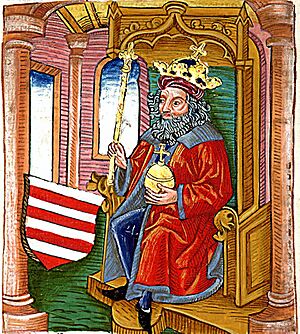Otto III, Duke of Bavaria facts for kids
Quick facts for kids Otto I (III) |
|
|---|---|
 |
|
| King of Hungary and Croatia Contested by Charles I |
|
| Reign | 6 December 1305 - June 1307 |
| Coronation | 6 December 1305, Székesfehérvár |
| Predecessor | Wenceslaus |
| Successor | Charles I |
| Duke of Lower Bavaria | |
| Reign | 3 February 1290 – 9 November 1312 |
| Predecessor | Henry XIII |
| Successor | Henry XV |
| Born | 11 February 1261 Burghausen |
| Died | 9 November 1312 (aged 51) Landshut |
| Burial | Kloster Seligenthal, Landshut |
| Spouse | Catherine of Habsburg Agnes of Glogau |
| Issue among others... |
Henry XV, Duke of Bavaria |
| House | House of Wittelsbach |
| Father | Henry XIII, Duke of Bavaria |
| Mother | Elizabeth of Hungary |
| Religion | Roman Catholicism |
Otto III (born February 11, 1261 – died November 9, 1312) was an important ruler from the House of Wittelsbach. He was the Duke of Lower Bavaria for many years, from 1290 to 1312. He also became the King of Hungary and Croatia for a short time, between 1305 and 1307. However, another ruler named Charles Robert also claimed the Hungarian throne, which caused a lot of conflict.
Contents
Otto III's Life and Rule
Otto was born in a place called Burghausen. His parents were Henry XIII, Duke of Bavaria and Elizabeth of Hungary. When his father passed away in 1290, Otto became the Duke of Lower Bavaria. He ruled alongside his younger brothers, Louis III and Stephen I.
Challenges and Goals
Otto often disagreed with the powerful Habsburg family. He wanted to get back a region called Styria, which Bavaria had lost in 1180. He even supported Adolf, King of Germany in a battle against the Habsburgs.
Becoming King of Hungary
Because Otto was a grandson of Béla IV of Hungary, he was offered the Hungarian crown in 1301. At first, he didn't accept it. But in 1305, another ruler, Wenceslaus III of Bohemia, gave up his claim to Hungary in favor of Otto.
To reach Hungary, Otto had to be very clever. The Habsburg ruler Albert I of Germany was blocking the usual routes through Austria. So, Otto dressed up as a merchant to hide his identity. He successfully reached Buda in November 1305.
Coronation and Struggles
Otto was crowned with the special Holy Crown of Hungary on December 6, 1305. This happened in Székesfehérvár. However, it was hard for him to truly control the country. His rival, Charles of Anjou, was also trying to become king.
In 1306, Charles of Anjou took over several important castles and areas in northern Hungary. The next year, he even captured Buda. In June 1307, Otto visited a powerful leader named Ladislaus Kán, who was the Voivode of Transylvania. But Ladislaus Kán surprisingly put Otto in prison!
Leaving the Throne
On October 10, 1307, some important Hungarian nobles gathered and declared Charles king. However, many powerful leaders, including Ladislaus Kán, still didn't accept Charles. Later that year, Ladislaus Kán released Otto. Otto then left Hungary. Ladislaus Kán kept the Holy Crown, which made it difficult for Charles to be fully recognized as king.
Otto officially gave up his claim to the Hungarian throne in 1308. His time in Hungary and his conflicts with the Habsburgs actually weakened his position in Bavaria. He faced money problems because of these struggles. In Hungarian history, he is sometimes called an anti-king because his rule was during a time when there was no clear king, known as an interregnum.
Later Years in Bavaria
While Otto was busy in Hungary, his brother Stephen I ruled Lower Bavaria. In 1310, another war against the Habsburgs caused damage to Burghausen. Otto passed away in 1312 in Landshut.
After his death, his son, Henry XV, became the Duke of Lower Bavaria. Henry XV shared power with his cousins, Henry XIV and Otto IV. These cousins were the sons of Otto's brother, Stephen I. Later, John I, who was Henry XIV's son, was the last Duke of Lower Bavaria. After him, Louis IV, Holy Roman Emperor took over the region and brought the duchy back together in 1340.
Family Life and Children
Otto III was married twice during his life.
First Marriage
In January 1279, Otto married Catherine. She was the daughter of Rudolf I of Germany. Otto and Catherine had twin sons, Henry and Rudolph, in 1280. Sadly, both twins died in the same year. Catherine passed away on April 4, 1282. Otto remained a widower for 23 years after her death.
Second Marriage
On May 18, 1309, Otto married his second wife, Agnes of Glogau. She was the daughter of Henry III, Duke of Silesia-Glogau. Otto and Agnes had two children together:
- Agnes of Wittelsbach (born 1310 – died 1360)
- Henry XV, Duke of Bavaria (born August 28, 1312 – died June 18, 1333)
Otto died in Landshut.

